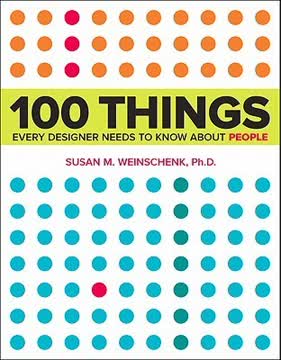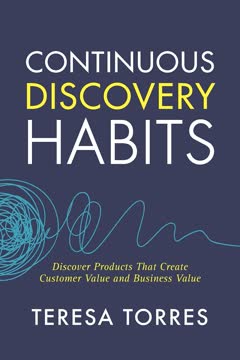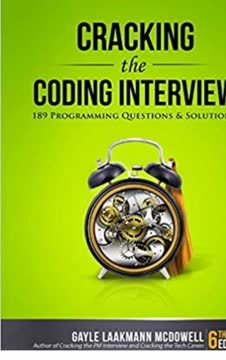Key Takeaways
1. Master the PM interview process: Understand company expectations and showcase your skills
Product management shouldn't be this elusive role, accessible only to those who are lucky (and connected) enough to have someone explain what PMing is all about.
Understand the interview process. Different companies have varying expectations and interview styles for PM candidates. Google focuses on product sense and analytical skills, while Amazon emphasizes leadership principles. Familiarize yourself with each company's specific approach and tailor your preparation accordingly.
Showcase key PM skills. Throughout the interview process, demonstrate:
- Strong communication and leadership abilities
- Analytical and problem-solving skills
- Technical competence (varies by company)
- User empathy and product design thinking
- Business acumen and strategic vision
2. Develop a compelling product pitch: Articulate your background, experience, and passion
This is your opportunity to connect your experience with the job you're interviewing for.
Craft a concise narrative. Prepare a 1-2 minute pitch that highlights:
- Your relevant background and experience
- Key accomplishments and impact
- Passion for technology and product development
- Why you're interested in the specific company and role
Tailor your pitch. Customize your story for each company, emphasizing experiences and skills that align with their product focus and culture. Practice delivering your pitch to ensure it sounds natural and engaging.
3. Conduct thorough company research: Demonstrate knowledge of products, strategy, and culture
Walking into your interview, you should be prepared to talk in depth about the following: One online product, one physical "offline" product, one product you purchased recently, your "favorite" product or website, a product you think is well designed, the company or team's product.
Research key areas. For each company, understand:
- Product lineup and features
- Target market and user base
- Business model and revenue streams
- Competitors and market positioning
- Company culture and values
- Recent news and product launches
Develop informed opinions. Based on your research, form thoughtful perspectives on:
- Strengths and weaknesses of the company's products
- Potential areas for improvement or expansion
- How the company's strategy aligns with market trends
4. Craft a standout PM resume: Highlight achievements, technical skills, and leadership experience
A resume isn't read; it's skimmed. A resume screener will glance at your resume for about 15 seconds (or maybe less) to make a decision about whether or not to interview you.
Focus on impact. Highlight specific achievements and quantifiable results:
- Revenue generated or costs saved
- User growth or engagement metrics improved
- Successful product launches or feature implementations
Showcase relevant skills. Emphasize:
- Technical skills (programming languages, data analysis tools)
- Product design and user research experience
- Project management and leadership abilities
Optimize for skimmability. Use:
- Concise bullet points (1-2 lines each)
- Strong action verbs
- Relevant keywords from the job description
5. Excel in behavioral interviews: Use structured responses to showcase problem-solving abilities
Behavioral questions are about your content and your communication.
Use the STAR method. Structure your responses with:
- Situation: Briefly describe the context
- Task: Explain your specific responsibility
- Action: Detail the steps you took
- Result: Highlight the outcome and impact
Prepare diverse examples. Have stories ready that demonstrate:
- Leadership and influence
- Dealing with challenges or conflicts
- Successful project execution
- Collaboration and teamwork
- Learning from failures
Practice active listening. Pay attention to the specific question asked and tailor your response accordingly. Be concise while providing enough detail to showcase your skills and impact.
6. Tackle product design questions: Focus on user needs and demonstrate structured thinking
Ultimately, these design questions are getting at how well you can show user empathy. Can you get inside the user's head and think about what that type of user would want?
Follow a structured approach:
- Clarify the problem and user needs
- Define target users and use cases
- Brainstorm potential solutions
- Prioritize features based on impact and feasibility
- Outline implementation and metrics for success
Demonstrate user empathy. Consider:
- User personas and their specific needs
- Pain points in current solutions
- How your proposed design addresses user goals
Think holistically. Consider:
- Business goals and constraints
- Technical feasibility
- Market trends and competitive landscape
7. Navigate estimation and technical questions: Showcase analytical and coding skills
Estimation questions are entirely about the process you take to solve them. It's the journey, not the destination, so to speak.
For estimation questions:
- Clarify assumptions
- Break down the problem into smaller components
- Make reasonable estimates for each component
- Show your work and explain your reasoning
- Sanity check your final answer
For coding questions:
- Discuss your approach before diving into code
- Write clean, readable code (even if pseudocode)
- Test your solution with sample inputs
- Analyze time and space complexity
- Discuss potential optimizations or trade-offs
8. Demonstrate strategic thinking: Analyze product decisions and market opportunities
Strategy questions include asking what a company's strategy is or how to design a strategy.
Analyze at multiple levels:
- Micro: Business model and user value proposition
- Macro: Company vision and market positioning
Consider key factors:
- Market size and growth potential
- Competitive landscape
- User needs and pain points
- Technological trends and capabilities
- Revenue streams and profitability
Develop frameworks. Use tools like:
- SWOT analysis (Strengths, Weaknesses, Opportunities, Threats)
- Porter's Five Forces
- Customer journey mapping
9. Master case study interviews: Apply frameworks to solve real-world product challenges
Case questions are aimed to get you to maximize profit, which is of course the difference between revenue and costs.
Follow a structured approach:
- Clarify the problem and objectives
- Gather relevant information
- Analyze the data and identify key insights
- Develop potential solutions
- Evaluate trade-offs and make recommendations
- Outline implementation steps and success metrics
Apply relevant frameworks. Use tools like:
- Business Model Canvas
- Product/Market Fit analysis
- Cost-benefit analysis
- User segmentation and personas
Practice quantitative reasoning. Be prepared to:
- Estimate market sizes
- Calculate key metrics (e.g., CAC, LTV, churn rate)
- Analyze pricing strategies
10. Develop essential PM skills: Balance technical knowledge, business acumen, and user empathy
A PM is responsible for making sure that a team ships a great product.
Cultivate a diverse skill set:
- Technical understanding: Ability to communicate with engineers and understand product feasibility
- Business acumen: Analyze market trends, competitive landscape, and revenue potential
- User empathy: Conduct user research, develop personas, and prioritize user needs
- Communication: Articulate product vision and collaborate across teams
- Data analysis: Use metrics to inform decision-making and measure success
Gain hands-on experience:
- Build side projects or contribute to open-source products
- Participate in hackathons or product design competitions
- Seek internships or rotational programs in product roles
Continuously learn and adapt:
- Stay updated on industry trends and emerging technologies
- Network with other PMs and attend product-focused events
- Seek mentorship from experienced product leaders
Last updated:
FAQ
What's Cracking the PM Interview about?
- Focus on Product Management: The book is a comprehensive guide for aspiring product managers, detailing the necessary skills and experiences to land a PM role in technology.
- Interview Preparation: It covers various aspects of the interview process, including types of questions, preparation strategies, and what companies seek in candidates.
- Real-World Insights: Authors Gayle Laakmann McDowell and Jackie Bavaro share insights from their experiences at top tech companies, making the content practical and relatable.
Why should I read Cracking the PM Interview?
- Expert Guidance: Authored by industry experts with firsthand experience in hiring and coaching PM candidates, offering valuable insights.
- Structured Approach: Provides a clear roadmap for breaking into product management, simplifying career navigation for readers.
- Comprehensive Resources: Includes real resumes, cover letters, and interview questions, serving as a practical toolkit for job seekers.
What are the key takeaways of Cracking the PM Interview?
- Understanding the PM Role: Emphasizes the importance of understanding what a product manager does and how the role varies across companies.
- Interview Strategies: Offers strategies for tackling different types of interview questions, including behavioral, estimation, and product design questions.
- Career Advancement Tips: Shares tips on advancing in a PM career, highlighting the importance of networking and continuous learning.
What types of interview questions are covered in Cracking the PM Interview?
- Behavioral Questions: Discusses preparation for questions assessing past experiences and their relevance to the PM role.
- Estimation Questions: Explains approaches to estimation questions, testing analytical thinking and problem-solving skills.
- Product Questions: Details handling product design and improvement questions, focusing on user needs and market fit.
How does Cracking the PM Interview define a successful product manager?
- Customer Advocate: A successful PM advocates for the customer, understanding their needs and translating them into product features.
- Cross-Functional Leader: PMs must lead without authority, influencing engineers, designers, and other stakeholders to achieve product goals.
- Data-Driven Decision Maker: Highlights the importance of using data to inform decisions, ensuring product strategies are backed by solid metrics.
What specific methods does Cracking the PM Interview recommend for preparing for interviews?
- Research the Company: Stresses understanding the company’s products, culture, and market position before the interview.
- Practice Mock Interviews: Recommends conducting mock interviews to practice responses to common PM questions and receive feedback.
- Develop a Personal Pitch: Advises crafting a concise personal pitch that highlights your background, skills, and fit for the role.
What are some common myths about product management addressed in Cracking the PM Interview?
- PMs are Project Managers: Clarifies that while some PMs may have project management responsibilities, their primary role is to define product vision and strategy.
- Technical Skills are Optional: Emphasizes that a technical background is beneficial for PMs, aiding in effective communication with engineering teams.
- You Need an MBA: Argues that an MBA is not a requirement for becoming a PM, as many successful PMs come from diverse backgrounds.
What advice does Cracking the PM Interview give for writing a strong resume?
- Be Concise and Impactful: Advises keeping resumes to one page and focusing on accomplishments rather than responsibilities.
- Use Metrics to Showcase Success: Encourages candidates to quantify achievements, such as “increased user engagement by 30%,” to demonstrate impact.
- Tailor Your Resume: Suggests customizing your resume for each application, highlighting relevant experiences that align with the job description.
What are the best quotes from Cracking the PM Interview and what do they mean?
- “Product management is a strange role.”: Highlights the unique nature of product management, where there is no clear path or formal training.
- “You need to learn to lead your team without authority.”: Emphasizes the importance of influence and collaboration in product management.
- “Taking the guesswork and randomness out of interviews is a good thing for everyone.”: Underscores the goal of demystifying the interview process.
How can I leverage Cracking the PM Interview for career advancement?
- Networking Strategies: Provides insights on building and leveraging a professional network, crucial for career growth in product management.
- Continuous Learning: Emphasizes ongoing education and skill development, encouraging PMs to stay updated on industry trends.
- Seeking Mentorship: Suggests finding mentors who can provide guidance and support, helping navigate your career path effectively.
What frameworks are recommended in Cracking the PM Interview?
- SWOT Analysis: Helps assess a product's strengths, weaknesses, opportunities, and threats, providing a structured way to evaluate strategic decisions.
- 4 Ps of Marketing: Focuses on Product, Price, Promotion, and Place, guiding PMs in developing effective marketing strategies.
- Customer Purchase Decision Making Process: Understanding this process helps PMs design products that align with customer needs and behaviors.
How can I effectively communicate my product vision during an interview?
- Articulate Goals Clearly: Define the product's goals and how it addresses user needs, ensuring alignment with the company's mission.
- Use Data to Support Ideas: Back up your vision with data or examples from successful products, demonstrating grounded ideas.
- Engage the Interviewer: Encourage dialogue by asking for the interviewer's thoughts, showing value for collaboration and feedback.
Review Summary
Cracking the PM Interview receives mostly positive reviews for its comprehensive coverage of product management roles and interview preparation. Readers praise its detailed insights, practical advice, and real-world examples. Many find it helpful for understanding PM responsibilities and company-specific interview processes. Some criticize its length and occasional dryness. While most recommend it for aspiring PMs, a few suggest it may not be sufficient on its own. Overall, reviewers consider it a valuable resource for those seeking PM positions or looking to improve their skills.
Similar Books










Download PDF
Download EPUB
.epub digital book format is ideal for reading ebooks on phones, tablets, and e-readers.






